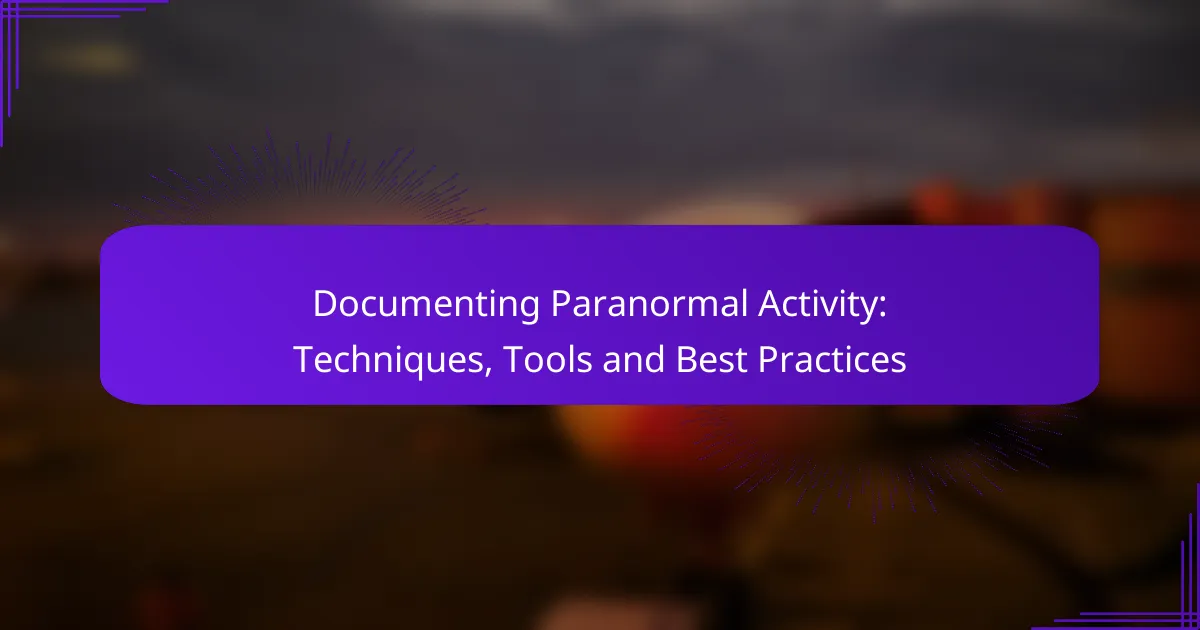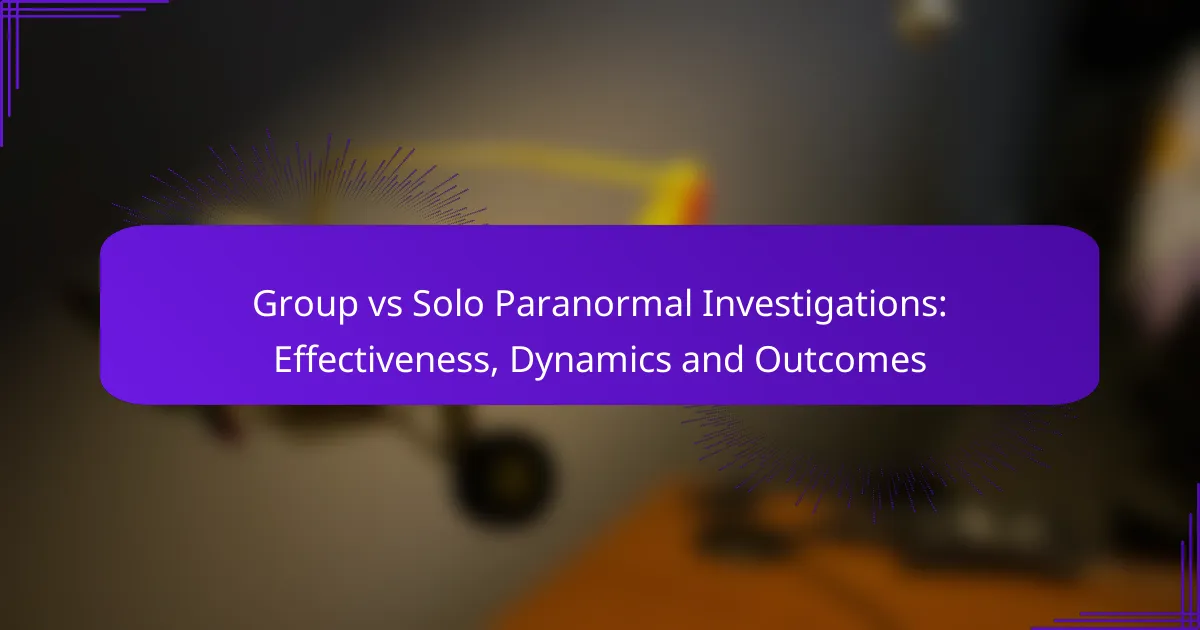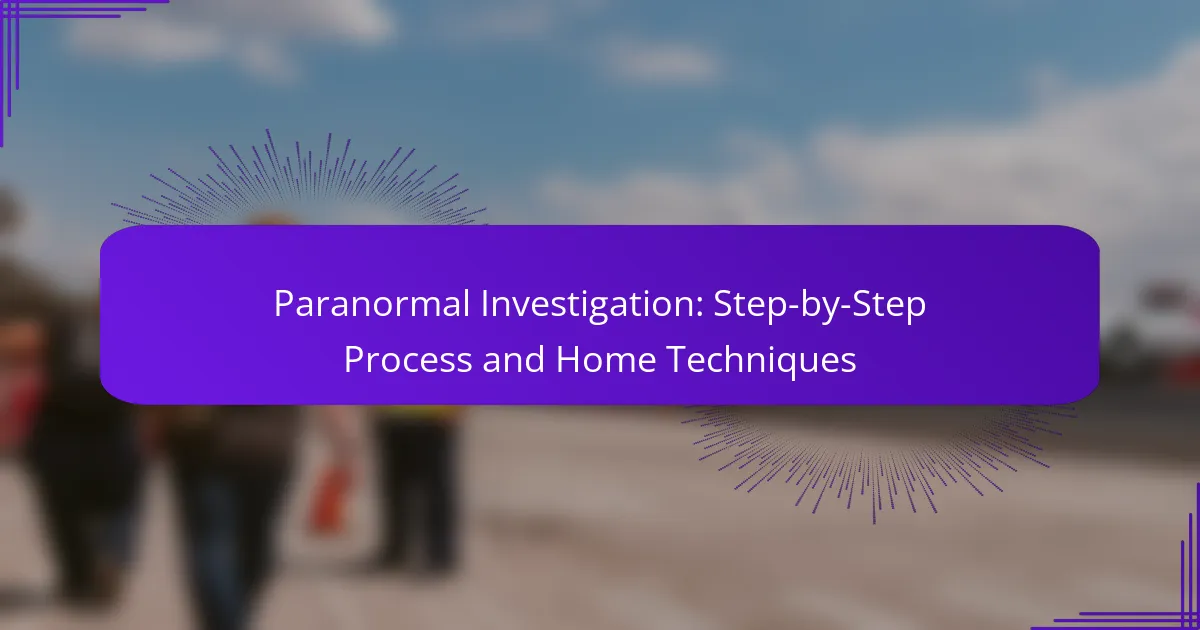Documenting paranormal activity involves a range of effective techniques and essential tools that help capture and analyze unexplained phenomena. By utilizing methods such as audio recordings, video documentation, and environmental monitoring, investigators can create a comprehensive account of experiences. Additionally, employing specialized tools like digital voice recorders and infrared cameras enhances the ability to gather credible evidence. Careful analysis of this documentation is crucial for determining the authenticity and relevance of the findings.
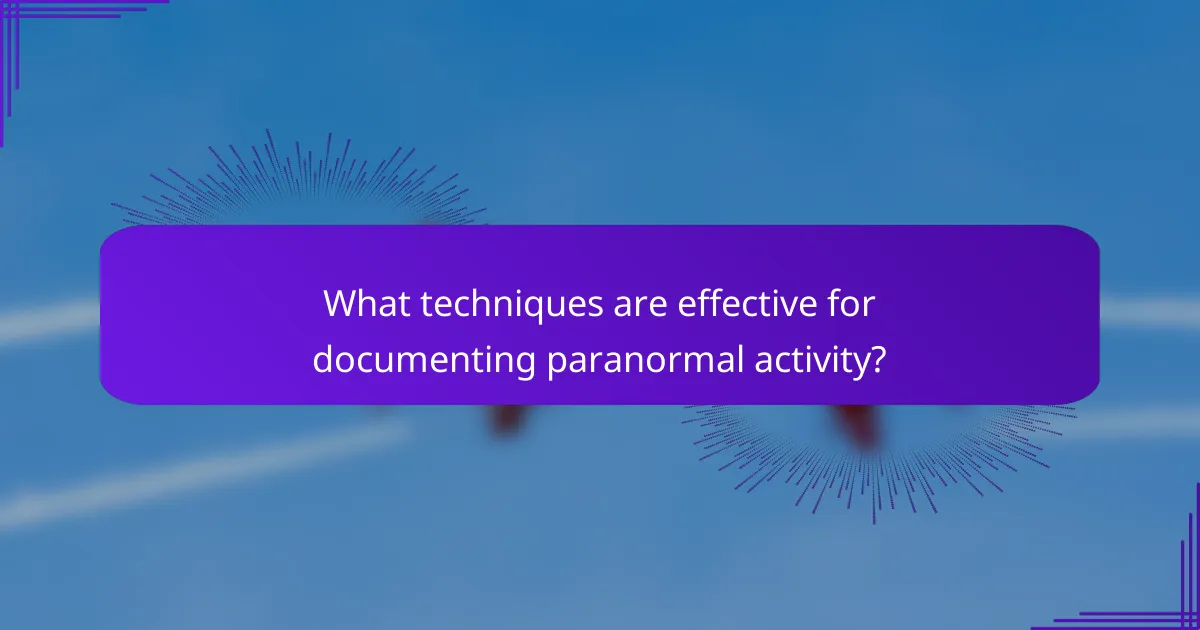
What techniques are effective for documenting paranormal activity?
Effective techniques for documenting paranormal activity include audio recordings, video documentation, written observations, environmental monitoring, and interviewing witnesses. Each method provides unique insights and helps create a comprehensive account of the experiences reported.
Audio recording methods
Audio recording is a crucial technique for capturing sounds that may indicate paranormal activity, such as unexplained noises or voices. Use high-quality digital recorders and ensure the environment is quiet to minimize background noise. Aim for recording sessions of at least 30 minutes to capture any potential occurrences.
Consider using external microphones for better sound quality. Always check the equipment before use and have backup batteries on hand to avoid interruptions during recordings.
Video documentation strategies
Video documentation allows for visual evidence of paranormal activity, capturing both the environment and any events that occur. Use high-definition cameras with night vision capabilities for low-light situations. Set up stationary cameras in areas of interest to monitor for extended periods.
When filming, ensure the camera is stable and has sufficient storage space. Review footage regularly to identify any unusual occurrences, and consider using time-lapse settings for long-term monitoring.
Written observation techniques
Written observations are essential for recording details about experiences, including date, time, location, and specific events. Keep a detailed journal to document each encounter, noting any emotional responses or physical sensations felt during the experience.
Use a structured format to ensure consistency, such as including sections for environmental conditions and any witnesses present. This information can provide context and help identify patterns over time.
Environmental monitoring
Environmental monitoring involves measuring factors like temperature, humidity, and electromagnetic fields, which can correlate with paranormal activity. Use tools like digital thermometers and EMF meters to gather data in areas where activity is reported.
Record measurements regularly and look for anomalies, such as sudden temperature drops or spikes in electromagnetic fields. This data can support claims of paranormal phenomena and help establish a baseline for future investigations.
Interviewing witnesses
Interviewing witnesses is vital for gathering firsthand accounts of paranormal experiences. Prepare open-ended questions that encourage detailed responses, focusing on what the witness saw, heard, or felt. Create a comfortable environment to help them share their experiences freely.
Take detailed notes during interviews and consider recording them with permission for accuracy. Analyze the information for common themes or discrepancies, which can provide insights into the nature of the reported activity.

What tools are essential for paranormal documentation?
Essential tools for documenting paranormal activity include digital voice recorders, infrared cameras, EMF meters, thermal imaging devices, and spirit boxes. Each tool serves a unique purpose and can help capture evidence of unexplained phenomena.
Digital voice recorders
Digital voice recorders are crucial for capturing audio evidence during paranormal investigations. They can pick up sounds that are inaudible to the human ear, such as whispers or unexplained noises.
When using a voice recorder, ensure it has good battery life and sufficient storage. Position it in areas where activity is reported, and allow it to run for extended periods to capture potential evidence.
Infrared cameras
Infrared cameras are designed to detect heat signatures and can reveal entities or anomalies not visible to the naked eye. These cameras are particularly useful in dark environments, making them ideal for nighttime investigations.
When selecting an infrared camera, consider resolution and sensitivity. High-resolution models can provide clearer images, while sensitive devices can detect even slight temperature variations.
EMF meters
EMF meters measure electromagnetic fields, which some believe can indicate paranormal activity. Fluctuations in EMF readings may suggest the presence of spirits or other entities.
To use an EMF meter effectively, familiarize yourself with baseline readings in normal environments. Look for significant spikes in areas where paranormal activity is reported, but be aware of potential interference from electronic devices.
Thermal imaging devices
Thermal imaging devices visualize heat emitted by objects, allowing investigators to see temperature variations that may indicate paranormal presence. These devices can highlight cold spots or unusual heat patterns.
When using thermal imaging, aim for areas with reported activity and scan slowly to capture detailed images. Be cautious of environmental factors that may affect readings, such as drafts or heat sources.
Spirit boxes
Spirit boxes are electronic devices that scan radio frequencies to facilitate communication with spirits. Users often report hearing voices or responses during sessions, making them popular among paranormal investigators.
To maximize the effectiveness of a spirit box, conduct sessions in quiet locations and ask clear, direct questions. Record the sessions for later analysis, as responses may be subtle and require careful listening.
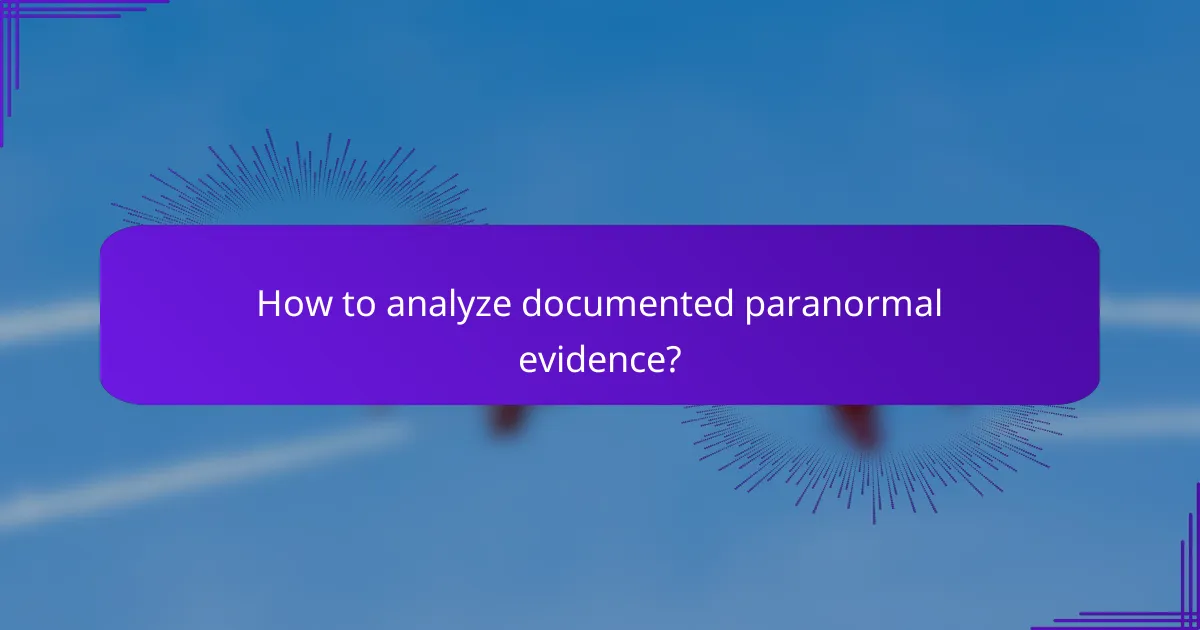
How to analyze documented paranormal evidence?
Analyzing documented paranormal evidence involves evaluating the data collected to determine its authenticity and relevance. This process requires careful examination of various types of evidence, including audio, video, and other documentation, to identify patterns or anomalies that may suggest paranormal activity.
Data comparison methods
Data comparison methods involve contrasting documented evidence against known benchmarks or similar cases. This can include comparing temperature readings, electromagnetic field (EMF) fluctuations, or other environmental data to establish anomalies that could indicate paranormal phenomena.
Utilize software tools to visualize data trends over time, which can help in identifying unusual spikes or drops. For instance, a sudden increase in EMF readings in a specific location could warrant further investigation.
Audio analysis techniques
Audio analysis techniques focus on examining recorded sounds for anomalies that may suggest paranormal activity. This includes identifying unexplained voices, sounds, or frequencies that are not present in the surrounding environment.
Use software like Audacity or Adobe Audition to isolate sounds and enhance audio clarity. Look for patterns such as repetitive phrases or sounds that occur during specific times, which could indicate intelligent responses.
Video review processes
Video review processes involve scrutinizing recorded footage for unusual movements or entities. This can include frame-by-frame analysis to detect subtle changes that may not be visible at normal speed.
Consider using video enhancement software to improve image quality and clarity. Pay attention to shadows, reflections, or sudden movements that could suggest paranormal activity, and document any findings meticulously for further analysis.

What are the best practices for documenting paranormal activity?
Best practices for documenting paranormal activity involve systematic observation, clear protocols, and collaboration among investigators. These practices help ensure that findings are credible, reproducible, and useful for further study.
Establishing a documentation protocol
Creating a documentation protocol is essential for consistency in paranormal investigations. This protocol should outline what data to collect, how to record it, and the tools to use. For example, investigators might decide to use audio recorders, video cameras, and notebooks to capture their observations.
It’s beneficial to include specific guidelines on time stamps, location details, and environmental conditions. This information can provide context for any phenomena observed and help in analyzing the data later.
Maintaining objectivity
Objectivity is crucial in documenting paranormal activity to avoid bias in observations and interpretations. Investigators should strive to remain neutral and avoid jumping to conclusions based on personal beliefs or experiences. Keeping a detailed log of events as they occur can help maintain this objectivity.
Using standardized equipment and methods can also reduce subjective influence. For instance, employing the same type of recording devices across different investigations allows for more reliable comparisons of data.
Collaborating with other investigators
Collaboration with other investigators can enhance the quality and credibility of paranormal research. Working in teams allows for diverse perspectives and shared expertise, which can lead to more thorough documentation and analysis. Regular meetings to discuss findings and methodologies can foster a collaborative environment.
Additionally, sharing data and experiences with other groups can help identify patterns or anomalies that may not be apparent in isolated investigations. This collective approach can strengthen the overall understanding of paranormal phenomena.
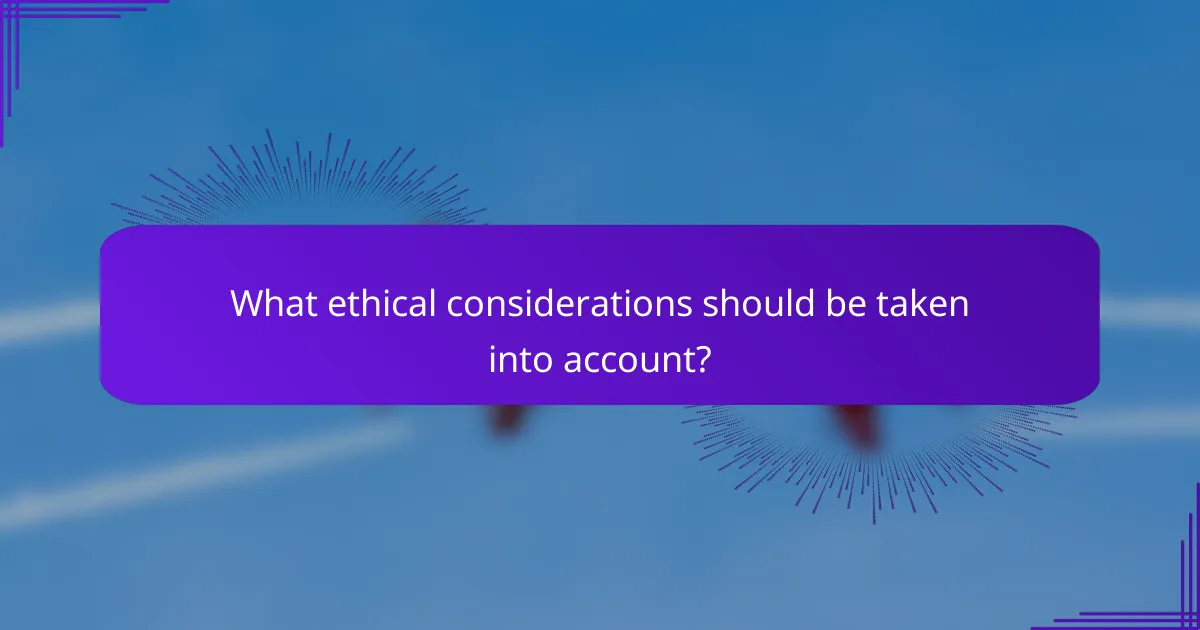
What ethical considerations should be taken into account?
When documenting paranormal activity, it is crucial to prioritize ethical considerations to ensure respect for individuals and locations involved. This includes maintaining privacy, obtaining consent, and being mindful of the potential impact on those who may be affected by the documentation process.
Respecting locations and privacy
Respecting locations involves understanding the significance of the site and the feelings of those who may have a connection to it. Always seek permission before entering private properties and be aware of any local regulations regarding trespassing or filming.
Additionally, consider the privacy of individuals who may be present during investigations. Avoid capturing identifiable information without consent, and be sensitive to how your documentation might affect the reputation or feelings of the location’s owners or nearby residents.
Informed consent from witnesses
Informed consent is essential when involving witnesses in your documentation of paranormal activity. Ensure that individuals understand the purpose of your investigation and how their contributions may be used, whether in reports, videos, or public presentations.
Provide clear information about the potential risks and benefits of participation, and allow witnesses to withdraw their consent at any time. This transparency fosters trust and ensures that everyone involved feels comfortable and respected throughout the process.
